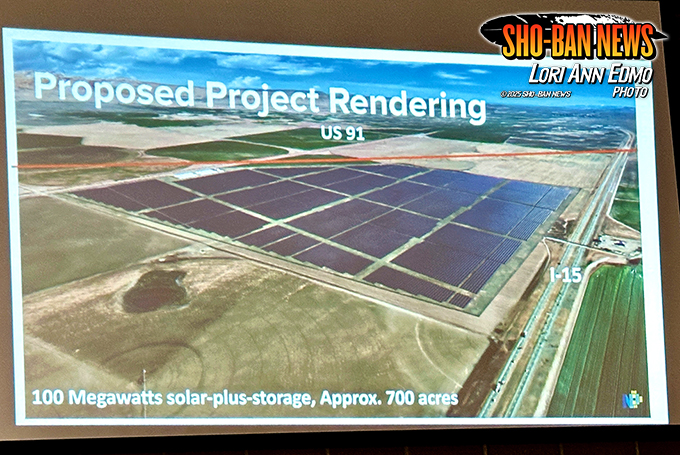Land Use Policy Commission conducts public hearing for proposed solar farm

A rendering shown of the proposed project land between U.S. Hwy 91 and I-15 at the TBC Dome Room on November 14.
By LORI ANN EDMO
Sho-Ban News
FORT HALL — Shoshone-Bannock tribal members have until November 24 at 4 p.m. to submit their comments on Navajo Power’s Solar Project proposal with the Shoshone-Bannock Tribes.
The Tribes Land Use Policy Commission conducted a Special Use Permit public hearing November 14 in the Tribal Business Center Dome Room that many attended.
Navajo Power is proposing to lease 704 acres of previously disturbed land from the Tribes between Interstate 15 and Highway 91 for 40 years to develop a 100-megawatt solar project and storage facility they’re referring to as SBT Solar.
Alana Edmo, Tribal Energy Resources manager, said the proposal originated in 2020 when she worked with the National Renewable Energy Laboratory to explore possible options. At that time the concept didn’t advance because of concerns with the ownership model. Since then, new federal programs especially those created under the Inflation Reduction Act expanded opportunities for tribes to pursue renewable energy development as full partners. The Fort Hall Business Council asked their program to revisit potential solar opportunities.
She said they did research looking at tribal lands, met with different developers including Navajo Power to explore the project further to see if it’s viable. She noted they’re in the beginning phases and nothing is binding. “We are just being transparent and listen to you and your concerns and make decisions based on those,” she said at the hearing.
Brent Isaac, Navajo Power CEO, explained they are an energy development company that he founded in 2018 and they’re a majority Native-owned company. He said these projects take a number of years.
Adel Barrett, senior director of development, explained the PowerPoint images of the solar panel, photovoltaic cells that convert the sunlight into electricity and the modules have an aluminum frame. They have steel racking that goes into a concrete foundation into the ground. The panels are arranged in rows, north-south and they’re on trackers. They’re mechanized as the sun is moving east to west, the panels track the sun. The electricity is collected at the inverter, combiner box and it goes to the grid. The grid is large transmission lines and there’s’ one that crosses nearby the site that are typically owned by utilities. They are proposing putting an energy storage system on the project that is a battery – what it will do is while the sun I shining the battery will be charged and when the sun stops shining in the evening, it will be on-key when the battery will be discharging. “So all that stored energy will be discharged to the grid at that time,” Barrett said.
They’re proposing to put native vegetation underneath the panels. They don’t need an additional transmission line to be built. She said it’s a great spot.
Japhet Koteen, senior project development manager, said the location is a solid site. He explained the environmental benefits converting from commercial agriculture to renewable energy solar farm. Compared to agricultural where the dust comes up, it’s tilled and use fertilizers and pesticides. He said solar needs very little water. The solar cells are sealed in glass. They don’t produce air pollution. Koteen said they put a bond on the project that pays for restoration if for example there’s a freak hail storm or elk come down and tear it apart. The bond pays for the cost of taking everything out and restoring the land back to the state it can be used for something else. The project is in the early stage of development. When construction is started (they hope in 2027) it will take about 12 to 18 months to get the project built.
Ceceilia Tso, Community Relations director and workforce development, said the project brings jobs, they provide training, much of it is online and one just needs to be a tribal member to get into the programs.
Dan Ariwite, tribal member, said there needs to be no state or county involvement. He believes county lines need to be erased and encourages the FHBC to do that to be more sovereign. He also questioned whether Idaho Power would allow access to the grid? He asked what would be done with the solar panels once the project is done and whether it’s hazardous material or who would dispose of it?
Issac, Navajo Power CEO, said solar panels in the 80s and 90s were made from cadmium that resulted in hazardous waste. But new technology for solar is silica, aluminum, glass and metal that is non-hazardous. He said the panels are tested and the only dangerous aspect is electrical. They produce electricity when the sunlight is out.

Navajo Power’s solar project representatives speak.
Nancy Eschief Murillo asked what the project cost is and Koteen estimated it’s around $200 million. She also asked who is paying for it and Issac from Navajo Power said they are and will go to the marketplace for that. In addition, there are loan programs through the Bureau of Indian Affairs and Department of Energy – the DOE has a loan fund called Tribal Loan Guarantee Program there they wouldn’t access it but they help facilitate the Tribes position. He said their capital is on the private side and they raise money from a different capital market.
She also asked why they’re putting it on agricultural land, why not put it somewhere else? She also wanted to know how high the panels are. Issac said they’re about six to 14 feet high. Nancy believes they need to find another location for it.
Russell Haskett asked how much is the Tribes going to make off the project? Koteen said he could give a non-answer because Navajo Power has to negotiate with LUPC and the FHBC – once they get approval for the permit they will know more. They can’t sign a lease until they get a permit. Russell also asked about environmental assessment and Koteen replied because it’s previously disturbed land it is a categorical exclusion from environmental assessment according to Department of Interior rules. However, he said the Tribe has an environmental review process, so they’ve submitted their documentation for tribal environmental departments to review. Russell asked about the lease, why it needed to be 40 years? Koteen said they generally set the lease term for 20 years and there’s a series of options after that. Haskett also wanted to know if there were other solar companies that were sought out? Alana Edmo said they assessed several different developers including some big corporations. Some wind power companies have also been explored. The reason they chose Navajo Power is because they offered the Tribes flexibility.
Louida Benally asked how many other tribes Navajo Power did business with and Barrett said there was about three large projects of about 100 megawatt each, but that was at her previous company. At this company, the tribal leasing process takes a long time. Benally also asked if they could provide names of the other tribes they’ve done work with. Barrett said there may be confidentiality agreements with them so she could only say Navajo Nation. Benally said she’d be more comfortable if she talked to someone like getting references.
Debbie Rodriguez wanted the same information. Isaac explained Moapa Tribe in Nevada is the only other tribe that has a project of this size. They are successful but they have a special relationship with Nevada Energy in Las Vegas. She also wanted to know how Navajo Power connected with the Tribes after reading the hearing notice on Facebook thinking it’s the first time she heard of it. She questioned why a public hearing was needed so fast normally it’s taken to the reservation districts first so tribal members can comment on it then the public hearing. “It just seemed like everything happened so fast,” she said. Isaac said they introduced their link at a conference and had conversations early on with the Tribes. He explained they did the initial work to provide answers for tribal members.
Jeanette Wolfley asked if any tribal department signed off on the categorical exclusion for an environmental assessment. Koteen replied he isn’t aware of one but some folks have submitted comments. He hasn’t yet seen the checklist. She also asked what Water Resources Department position is on it? Koteen said he spoke with Gail Martin a couple of weeks ago but is waiting for her comments. Jeanette asked if Navajo Solar hasn’t yet done a project of this size but do they have the capability to raise capital? Barrett said she has personally financed over 300 megawatts of projects at former companies. They’ve also closed two deals with capital providers on Navajo Nation projects. Wolfley also asked if Navajo Solar has a commitment from Idaho Power or INL to purchase the energy? Barrett said utilities are conservative beings and what they want to see if they’re going to hang their hat on buying power from you project what do have in exchange whether there is a lease. They don’t have a lease yet and they want to know if they have studies as they want to see a project that is low risk. “At this point we have nothing to sell them,” Barrett continued. Once they have a lease then they can go to utilities. Issac said the studies are expensive costs that factor in and utilities often wait until they are done to make commitments.
Fred Auck asked whether the project is spiritually connected and it seems to be all about money. He said the ground can never be bought. He sees a lot of things happening to Mother Earth.
Velda Racehorse said the antelope migrate through there and the elk come across. She asked whether the solar panels are elk friendly? She asked what the impact to the soil is and the groundwater needs to be protected.
Cecil Breland asked who chose the location? It’s in an agriculture lease. He believes they’re putting the cart before the horse. He believes they need to find idle ground that is not being used.
LUPC Chairperson Laurie Kniffin said once they review the comments after the closing date they have seven working days to send recommendations to the FHBC.





